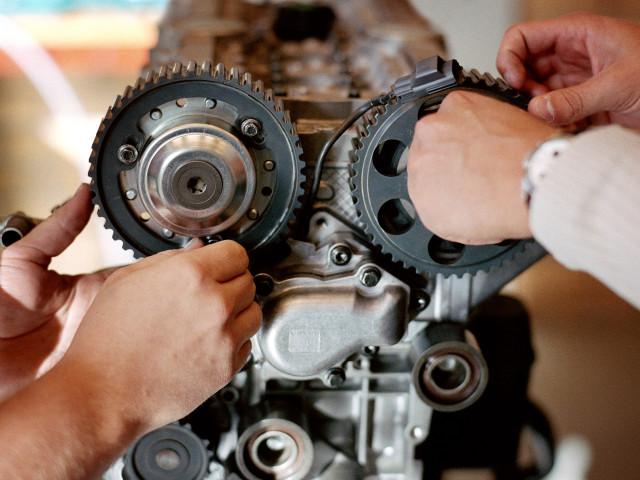The course is problem based, where you develop your knowledge and skills by working with hydrodynamic analysis, hull structural design, and system evaluation, for a particular high-speed craft. The design work is supported by a number of seminars on topics such as:design principles and criteria; principles of lightweight structures in general and high speed craft hull structures in particular and related modelling methods; principles of high-speed hydrodynamics and related modelling methods; design methods, standards and classification rules. Professional high-speed craft designers are invited as guest lecturers and the course gives detailed insight in the high-speed craft related research going on at KTH.
SD2705 High-Speed Craft 6.0 credits

Information per course offering
Choose semester and course offering to see current information and more about the course, such as course syllabus, study period, and application information.
Information for Autumn 2026 Start 26 Oct 2026 programme students
- Course location
KTH Campus
- Duration
- 26 Oct 2026 - 11 Jan 2027
- Periods
Autumn 2026: P2 (6 hp)
- Pace of study
33%
- Application code
11277
- Form of study
Normal Daytime
- Language of instruction
English
- Course memo
- Course memo is not published
- Number of places
Max: 16
- Target group
- Open för TMRSM, TMEGM as long as it can be included in your program.
- Planned modular schedule
- [object Object]
- Schedule
- Schedule is not published
Contact
Course syllabus as PDF
Please note: all information from the Course syllabus is available on this page in an accessible format.
Course syllabus SD2705 (Spring 2022–)Content and learning outcomes
Course contents
Intended learning outcomes
There are various motivations for travelling in high-speed at sea. For example for search and rescue vessels it is crucial to quickly respond to life threatening situations; for patrol craft it may be the ability to cover large coastal areas or intercept threats; while for racing boats it is the urge to win. Independently of which motivation and what type of craft, designing high-speed craft involves great engineering challenges, where the hull geometry, structure, engine and propulsion arrangement, and crew and passenger safety and comfort, have to be carefully balanced to make the craft safe and efficient to a feasible cost and with limited environmental impact.
The purpose with this course is to:
- deepen your general knowledge and skills in mechanical engineering and engineering design,
- develop your engineering communication skills and engineering judgement, and
- make you prepared to meet some of the challenges involved in high-speed craft design.
You will learn about and implement methods for hydrodynamic and structure analysis and apply these methods when designing a particular high-speed craft.
The objective is that you after finishing the course should be able to:
(Knowledge and understanding)
1. demonstrate broad knowledge and understanding of the scientific basis and proven experience of high-speed craft design, deeper methodological knowledge, and insight into current research and development work;
(Skills and abilities)
2. demonstrate an ability, from a holistic perspective, to critically, independently and creatively
a) formulate and analyse design requirements for high-speed craft,
b) identify and formulate the related design challenges,
c) create, analyse and evaluate different solutions for the hull structure and other parts of high-speed craft,
using appropriate methods and taking into account people’s situations and needs and the society’s objectives for economically, socially and ecologically sustainable development;
3. demonstrate an ability to engage in teamwork and cooperation in groups of varying composition;
4. demonstrate an ability to clearly present and discuss high-speed craft design aspects with reference to relevant theory and with use of appropriate terminology, orally as well as in writing in dialogue with different groups;
(Judgement and approach)
5. demonstrate an ability to evaluate high-speed craft concerning technical efficiency, and related social and economic aspects, as well as environmental and work environmental aspects
Literature and preparations
Specific prerequisites
SD2411 Lightweight Structures and FEM or similar. Students taking (or having taken) the course SD2416 Structural Optimisation and Sandwich Design and students following the Master of Science Programs in Naval Architecture and Maritime Engineering have priority.
English B / English 6
Literature
Examination and completion
Grading scale
Examination
- PRO2 - Design Project, 6.0 credits, grading scale: A, B, C, D, E, FX, F
Based on recommendation from KTH’s coordinator for disabilities, the examiner will decide how to adapt an examination for students with documented disability.
The examiner may apply another examination format when re-examining individual students.
If the course is discontinued, students may request to be examined during the following two academic years.
Other requirements for final grade
Examination is based on your active participation on the seminars and your final design project report (ÖVN1, 6 ECTS).
Examiner
Ethical approach
- All members of a group are responsible for the group's work.
- In any assessment, every student shall honestly disclose any help received and sources used.
- In an oral assessment, every student shall be able to present and answer questions about the entire assignment and solution.